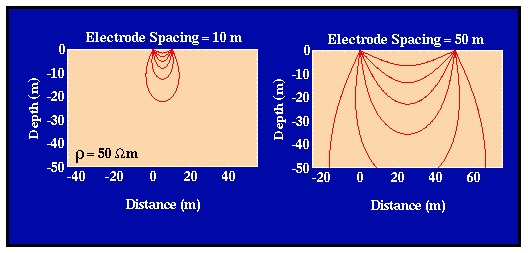
As shown previously, when two current electrodes are moved in close proximity to one another, current flows along arc-shaped paths connecting the two electrodes. If the earth has a constant resistivity, about 50% of the current flows through rock at depths shallower than the current electrode spacing.

What this implies is that by increasing the electrode spacing, more of the injected current will flow to greater depths, as indicated in the figure above. Because the total resistance in the electrical path increases as electrode spacing is increased, to get current to flow over these longer paths requires a larger generator of electrical current. Thus, the maximum distance that current electrodes can be separated by is in part dictated by the size of the generator used to produce the current.
Assuming for a moment that we have a large enough generator to produce a measurable current in the ground at large current electrode spacings, this increase in the depth of current penetration as current electrode spacing increases suggests a way in which we could hope to decipher the resistivity structure of an area. Because current flows mostly near the Earth's surface for close electrode spacings, measurements of apparent resistivity at these electrode spacings will be dominated by the resistivity structure of the near surface. If the current and potential electrodes are spread apart and the apparent resistivity remeasured, these measurements will incorporate information on deeper Earth structure.
